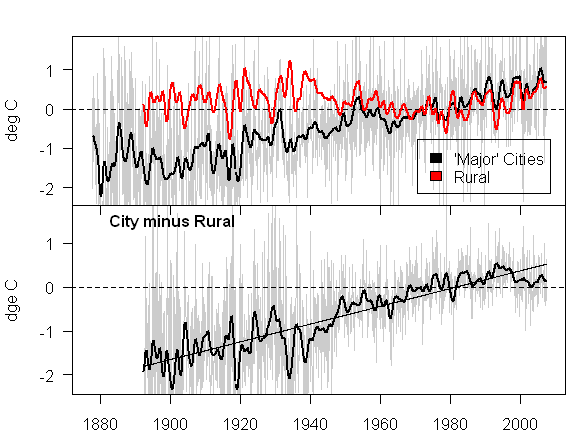Cities and Global Warming
OK, I lied. I have one more post I want to make on global warming now that Steve McIntyre's site is back up. I suspect I tend to bury the lede in my warming posts, because I try to be really careful to set up the conclusion in a fact-based way. However, for this post, I will try a different approach. Steven McIntyre has reshuffled the data in a study on urbanization and temperature that is relied on by the last IPCC report to get this chart for US Temperature data.
Conclusion? For this particular set of US temperature data, all the 20th century warming was observed in urban areas, and none was observed in rural areas less affected by urban heat islands, asphalt, cars, air conditioning, etc.
If it can be generalized, this is an amazing conclusion -- it would imply that the sum of US measured warming over the last century could be almost 100% attributed to urban heat islands (a different and more localized effect than CO2 greenhouse gas warming). Perhaps more importantly, outside of the US nearly all of the historical temperature measurement is in urban areas -- no one has 100 year temperature records for the Chinese countryside. However much this effect might be over-stating US temperature increases, it would probably be even more pronounced in measurements in other parts of the word.
OK, so how did he get this chart? Did he cherry-pick the data? First, a bit of background.
The 2003 Peterson study on urban effects on temperature was adopted as a key study for the last IPCC climate report. In that report, Peterson concluded:
Contrary to generally accepted wisdom, no statistically significant
impact of urbanization could be found in annual temperatures.
This study (which runs counter to both common sense and the preponderance of past studies) was latched onto by the IPCC to allow them to ignore urban heat island effects on historical temperatures and claim that most all past warming in the last half-century was due to CO2. Peterson's methodology was to take a list of several hundred US temperature stations (how he picked these is unclear, they are a mix of USHCN and non-USHCN sites) and divide them between "urban" and "rural" using various inputs, including satellite photos of night lights. Then he compared the temperature changes over the last century for the two groups, and declared them substantially identical.
However, McIntyre found a number of problems with his analysis. First, looking at Peterson's data set, he saw that the raw temperature measurement did show an urbanization effect of about 0.7C over the last century, a very large number. It turns out that Peterson never showed these raw numbers in his study, only the numbers after he applied layers of "corrections" to them, many of which appear to McIntyre to be statistically dubious. I discussed the weakness of this whole "adjustment" issue here.
Further, though, McIntyre found obviously rural sites lurking in the urban data, and vice versa, such that Peterson was really comparing a mixed bag with a mixed bag. For example, Snoqualmie Falls showed as urban -- I have been to Snoqualmie Falls several times, and while it is fairly close to Seattle, it is not urban. So McIntyre did a simple sort. He took from Peterson's urban data set only large cities, which he defined as having a major league sports franchise (yes, a bit arbitrary, but not bad). He then compared this narrower urban data set from Peterson against Peterson's rural set and got the chart above. The chart is entirely from Peterson's data set, with no cherry-picking except to clean up the urban list.
Postscript: Please don't get carried away. Satellite measurement of the troposphere, which are fairly immune to these urbanization effects, show the world has been warming, though far less than the amount shown in surface temperature databases.
Update: To reinforce the point about global sites, Brazil apparently only has six (6) sites in the worldwide database. That is about 1/200 of the number of sites in the continental US, which has about the same land area. And of those six, McIntyre compares urban vs. rural sites. Guess what he finds? And, as a follow up from the postscript, while satellites show the Northern Hemisphere is warming, it shows that the Southern Hemisphere is not.